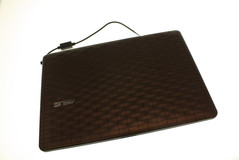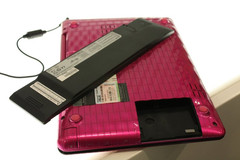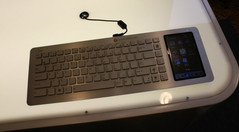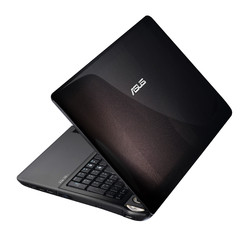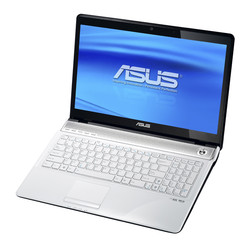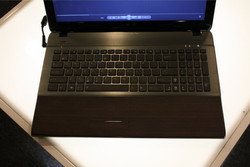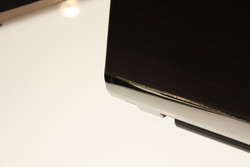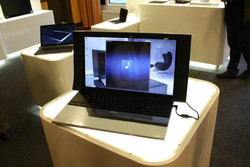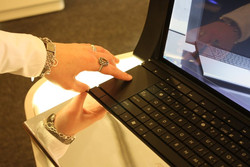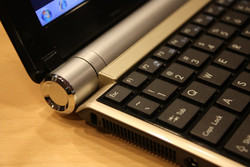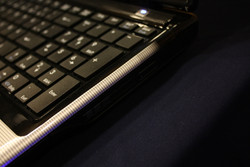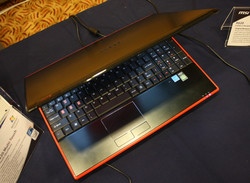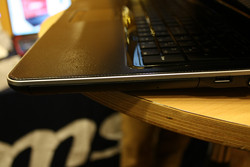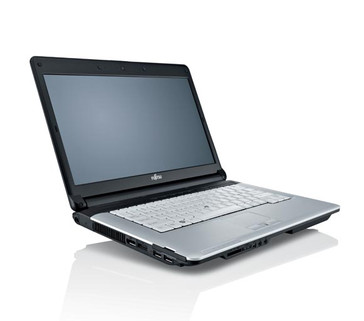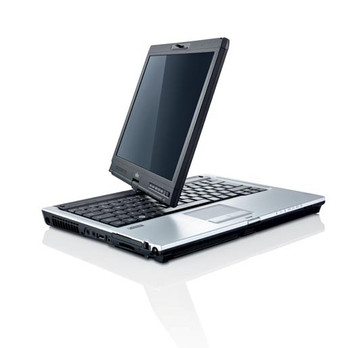NBC Onsite: Cebit news from Asus, Fujitsu and MSI
by Florian Wimmer 01/22/2010
Preview.
The notebook manufacturers, Asus, MSI and Fujitsu presented the novelties that will be waiting for the trade press and customers at the CeBIT 2010, starting on the 2nd of March, on an exclusive preview event. We were onsite for you and will summarize all innovations around bamboo notebooks, sound giants and chocolate miniatures.
Asus with new designs and materials
From design notebooks to gaming machines: Asus presented a total of eleven models at the event. Most of them have already been seen at the CES, Asus wants to first present the real highlights at the CeBIT, though.
Among the already shown devices, there were a few real highlights. For example the Asus EeePC Seashell 1008P that looks especially good. The 26.2 x 18 x 2.6 centimeter sized netbook is available in pink and brown, or as Asus has named them: "Hot Pink" and "Chocolate Brown".
The design has been created by New York's star designer, Karim Rashid, who is, for example, also currently designing the Nhow Hotel in Berlin. Because the designer likes to work with natural shapes, he has given Asus' trendy EeePC a wave pattern. Aside from that, the entire outer cover, even the bottom side, has been divided in squares. You could almost mistake the netbook for a handbag in a closed state, with which the EeePC should score with the fashion-aware target group.
If you'd rather be persuaded by technical facts, Asus has built-in an Intel Atom processor with 1.66 GHz, a 1024 MByte DDR2 RAM, a hard disk with 250 GBytes and 5400 revolutions per minute, as well as a WLAN module with 802.11n support, 2 USB 2.0 ports, a mini display port with an included VGA adapter and a SD cardreader.
The display has a 10.1 inch diagonal and a resolution of 1024x600 pixels so that an aspect ratio of ca. 17:10 is created. Asus executes the keyboard in the form of single keys, so a chiclet design.
The netbook is supposed to have a weight of 1100 grams, including the flat 3 cell lithium polymer battery. Asus adds in a second battery as a treat so that the time away from the mains can even be extended. According to Asus, one battery lasts for up to 6 hours; first tests on the internet established a runtime of 3-4 hours. Because the second battery is identical to the first, the runtime can, logically, be doubled.
This designer piece will cost 379 euro and the netbook typical Windows 7 starter and two year pickup and return service is included. Asus wants to launch the netbook on time for the CeBIT.
If you'd rather prefer an austere notebook, you can take the newest EeePC with the number 1005. Processor, RAM and integrated graphic card are the same as in the designer model, but you have to accept a greater maximum height of 3.65 centimeters. To make up, there is an additional USB port and a 6 cell lithium ion battery. We've already reviewed the 279 or respectively 299 euro expensive device.
The EeeKeyboard, a computer built completely into the keyboard, is also interesting. Certain functions can be addressed directly over a display that has about the size of a smart phone. Actually, the EeeKeyboard has been conceived for connecting it via wireless HDMI to a monitor and then, for example, work or surf comfortably from a sofa.
Multimedia and Gaming
Asus presented five new models as multimedia notebooks. The models have the names N61JV and N61JA for the 16 inch format and N71JV and N71JA for the 17.3 inch notebooks.
First, the 16 inchers: Asus builds a Core i5-430M with 2.26 to 2.53 GHz and an nVidia Geforce GT 325M with a 1024 GByte graphic memory into the N61JV. The N61JA only differs from its sister model in these two components. A Core i5-520M with 2.4 to 2.93 GHz is implemented here, as well as a Radeon HD 5730 with 1024 MByte video RAM.
The N61 models share all other specifications: The 16 inch 16:9 screen with a resolution of 1366x768 pixels, the 4 GByte DDR3 1066 RAM and the 500 GByte sized hard disk with 5 400 revolutions per minute and the 6 cell lithium ion battery.
The only other difference is the price: With 999 euro, the N61JA costs around 100 euro more than the N61JV with 899 euro.
Asus does exactly the same for the 17.3 inchers in terms of processors and graphic cards as for the smaller models: Core i5-430M and Geforce GT325M in the N71JV and a Core i5-520M and Radeon 5730 in the N71JA.
Both devices have a display resolution of 1600x900 pixels. Equally identical are the 4 GByte DDR3 1066 RAM and 6 cell lithium ion battery. But there is a difference in the superiorly equipped N71JA in the memory unit. Instead of a 500 GByte disk as in the JV model, two 320 GByte HDDs are used here.
Asus recommends a retail price of 999 euro for the N71JV; the N71JA is supposed to cost 1079 euro.
The K52JR has a 15.6 inch display and has been rather more conceived as a starter device. This can already be seen on the applied processor: The Core i3-350M with 2.26 GHz, but with the Radeon HD 5470, should provide sufficient performance for basic multimedia tasks to start with.
The 2.7 kilogram heavy device with dimensions of 38 x 25.5 x 3.5 centimeters is already available in retail. Asus' recommends a retail price of 749 euro.
The G73Jh, the newest sprout from Asus' "Republic of Gamers" series, should be interesting for all gamers. We'll dedicate an own hands-on for the 17.3 inch gaming machine with an unusual design and the brand new Radeon HD 5870 graphic card.
Designer Notebooks
Traditionally, the somewhat different notebooks are collected in the stylish U-range or, as in the case of the Bamboo Collection, strike with unusual materials.
As already last year and as the name already implies, Asus has selected the renewable raw material bamboo that is also very stable and even looks good. Asus makes the wrist rest and lid out of the organic material and the manufacturer uses brushed aluminum for the keyboard bezel. The design is completed by a chiclet keyboard.
Not all details were known because the Bamboo Collection will first be launched onto the market in the second quarter of 2010. For the 15.6 inch devices, Asus wants to use a Core i5 and Core i3 processors, and build in a 4096 MByte DDR3 RAM in any case and use Intel's HM55 chip set. The displayed sample with the model number U53, had display a LED backlight and a resolution of 1366x768 pixels.
The Asus NX90 is especially focused on a powerful sound aside from design, which has been created in collaboration with David Lewis, the Chief Designer of the famous premium brand Bang and Olufsen.
Because the Danish company is especially known for its high-end sound systems, it's no wonder that the loudspeakers are one of the most important design elements in the NX90. The sound components are built-in over the entire height with a good 5 centimeters of breadth on the display's left and right. However, the laptop's case tray only has the breadth of the screen so that the loudspeakers aren't covered in a closed state, either.
The sound, naturally, interested us the most, but we didn't get a final sound presentation at the preview because the USB dongle required by the device was missing.
The entire case lid and the wrist-rest are made of polished aluminum, which looks good but will likely lead to a few fingerprints, as well. It's striking that a touchpad couldn't be found in the wrist-rest.
For that, there are two big black areas left and right of the keyboard. If you touch them, you'll quickly find out that these are two touchpads. According to Asus, they are supposed to remind you of a DJ, who also uses two record players. If special applications, like a DJ program, will be given wasn't certain at our visit.
The very large-sized multimedia keys, which are found above the F keys and with which the volume can be controlled or the player could be used, were also striking. They definitely proved the NX90's orientation as a stylish media center that blends into a designer living room.
Depending on the configuration, the device is supposed to cost up to 2499 dollars, at least in America, and should also be released onto the Market on time for the CeBIT here.
MSI switches to Atom and 32nm
MSI also attended the preview event. We were introduced to the new upper class netbook beside the known and already reviewed U135, as well as to the extension of the consumer range, a new gaming notebook in a known outfit and a slim device.
The MSI Wind U160, kept completely in brown tones, started our expedition across MSI's booth. The netbook with a 10.1 inch display, Intel's Atom N450 processor as well as a one GByte RAM and a 250 GByte hard disk memory represents the new top model of MSI's netbook lineup.
The design seemed to have found appreciation by the iF Design Award's jury, as they awarded the device with the Product Design Award 2010. Maybe this was because of the chiclet keyboard that MSI wants to apply to all new products.
The battery is to last for 9 hours, the case is not even one centimeter slim. The device that only weighs one kilogram strikes you when it's picked up, it's definitely light. The device can be optionally configured with a HSDPA module, which makes it interesting for mobile providers who could offer it fairly cheap in connection with a contract.
Multimedia Notebooks
As to the notebooks, MSI extends its Classic Line by a 15.6 inch notebook called CR620 and a 17.3 inch notebook called CR720. Both are of course equipped with the new Arrandale Core i5 and Core i3 processors and have a chiclet keyboard, which even supplies a numerical block. The power consumption can be reduced by pressing a button with the MSI Eco Engine and a HDMI provides the necessary multimedia connection.
The models are supposed to have a 4 GByte RAM and a 640 or a 500 GByte hard disk. The design is quite classical; the wrist-rest is, just like the lid, made with an unobtrusive line pattern and a glossy finish.
The Classic Line notebooks are to be available in the first quarter of 2010, also likely on time for the CeBIT.
Gaming Notebooks
MSI presented the GX640 and the GX740 as the new top models that are to round off MSI's gaming portfolio towards the top, with a 16 and 17 inch display and are equipped with a fast Core i5 processor and graphic cards from the Radeon HD5800 range.
The looks should already be familiar: The red stripe that runs around the case, the aluminum wrist-rest and lid and the WSAD keys highlighted in red should still be known from the last gaming generation. MSI still uses 16:10 displays, as already in previous generations and doesn't follow the trend of the lower 16:9 screens.
500 GByte of hard disk memory should satisfy gamers just like the built-in 4 GByte RAM. MSI even treats the GX740 to 4 loudspeakers and a subwoofer, as already in the forerunner model, to provide surround sound even on a laptop.
MSI's nine top gaming models are to be available on time for the CeBIT. There are even rumors about a further top model, which is, however, to first be revealed at the CeBIT.
MSI wants to extend its gaming line by the new GE models on the lower level. The GE600 is, as the name already hints, a 16 incher, the GE700 logically a 17 incher. Both notebooks are to create the link between gaming and entertainment. For this, MSI builds in a sound system with a subwoofer and a dedicated graphic card, which however can be disabled for energy saving reasons. Then the graphic integrated into the chip set is available for simpler applications.
Even the GE models compute with Intel's new 32nm processors and have a dedicated graphic card from ATI. The GE range is also supposed be available in retail on time for the CeBIT.
Subnotebooks
MSI also sees the ultra slim laptops as an important sector, which is represented by the X-Slim range. It's also to be extended.
The newest product is called X620, is 2.4 inches thin, has a 15.6 inch display, and contains a ULV processor from Intel, as well as a Radeon HD5430 and even a DVD drive. Like the Wind U160, the product has been awarded with the iF design award, which suggests that the X620's case has been designed a bit differently than most other notebooks.
Rounded edges, a structured surface that reminds of a leather handbag with its looks, and clever details, like a separate button above the keyboard that opens the DVD drive or a key for disabling the touchpad, appealed to the iF Award jury and to us, too.
The keyboard has been executed fittingly to the new MSI line as a chiclet variation; the fairly small touchpad has knobs for a faster palpability. MSI also offers a hybrid graphic solution for the X620 so that you can switch between the dedicated graphic card and the onboard solution. However, there won't be a UMTS module available for the X620.
Fujitsu with business and tablet
The Japanese from Fujitsu seem to not only put a focus on the CeBIT but especially on business customers so that both presented Lifebook models, S710 and T900, at the preview also rather address business customers.
Also seen at the CES and available within the next few weeks, the quite light, with a bit over 2 kilograms, S710 bids a matt 14 inch display, a 32nm Intel processor of the Core i3, i5, or i7 range and important features for business clients: A fingerprint reader is standard in the meantime, Fujitsu builds it in between both touchpad keys. Additionally, the hard disk is shock proof and a free-fall sensor is built-in.
Fujitsu also builds in an anti-theft system as a new security device, which makes it possible to delete the entire BIOS or hard disk as soon as an internet connection is built up after a theft.
Optionally, there is a TouchStick that reminds of the trackpoint known from Thinkpads. Diagonally above the touchpad, you'll find a separated, round field with which you can scroll, as a little highlight. It's a good idea for preventing an unintentional enabling of the scroll mode when the touch field is used.
The T900 is a tablet PC with multi-touch support and a 13.3 inch display, which can also be configured with almost all currently available 32nm processors from Intel's assortment. There is a Celeron processor on the configuration list for thrifty business people, too.
The 31.9 x 24.4 x 37 centimeter sized device should also be quite light with around 2 kilograms and have the mandatory fingerprint reader aside from a splash water protected keyboard.
The tablet PC is even optionally available with an especially deluxe glass touch screen from the company Berliner Glas. In any case, there is a cover included for the tablet PC when it's delivered, so you can transport it without scratches.
A short verdict
On the whole, the CeBIT won't likely have many surprises for those who followed the CES reports attentively. However, the manufacturers will probably have a few aces up their sleeves, which they will first reveal at the exhibition's opening. We'll naturally keep you up to date in our news section.





